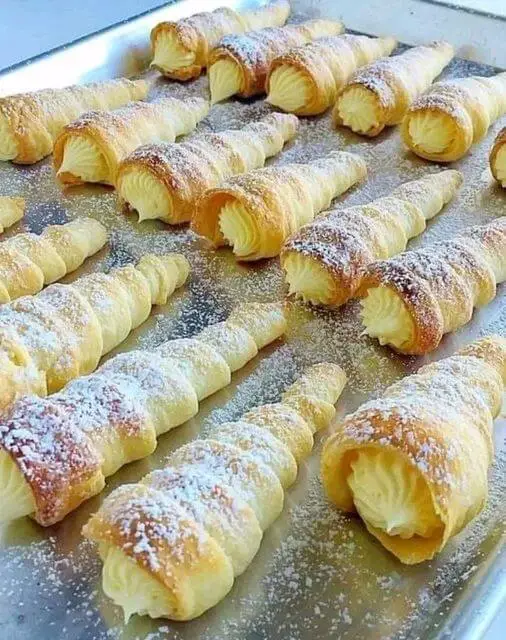Puff Pastry Cream Horns, also known as cream cones or cream rolls, are a delightful and elegant pastry. This dessert begins with a base of light and flaky puff pastry. The pastry is traditionally cut into narrow strips and then delicately wrapped around cone-shaped molds. These molds are often made of metal or heat-resistant material, designed to give the pastry its characteristic horn shape.
Once wrapped, the pastry is brushed with a light coating of egg wash, which gives it a beautiful golden-brown color upon baking. The baking process transforms the pastry into a crispy, airy shell with delicate layers that flake apart beautifully when bitten into.
After cooling, the hollow pastry shells are filled with a rich and creamy filling. The filling is typically a homemade whipped cream, sweetened and sometimes flavored with vanilla or a hint of citrus zest to add depth. However, variations might include fillings like pastry cream, chocolate mousse, or even fruit-flavored creams.
The final touch is often a dusting of powdered sugar over the top, adding a touch of sweetness and a visually appealing finish. Some variations might also include a drizzle of chocolate or caramel, or a sprinkling of nuts or fruit for added texture and flavor.
Puff Pastry Cream Horns are known for their delightful contrast between the crispy, buttery pastry and the soft, luxurious cream filling. They are often served at tea time or as a special dessert and are visually impressive, making them perfect for entertaining or special occasions.
Ingredients
For the custard cream
- 3 egg yolks
- 3 tablespoons (30 gr) of all-purpose flour
- 1/2 cup (100 gr) of sugar
- 1 teaspoon of vanilla extract
- 8 oz (235 ml) of milk
For the cannoncini
- 1 sheet of puff pastry, defrosted (about 8 oz, 225 gr)
- 1/4 cup (50 gr) of sugar
- 1 egg (for egg wash)
- powdered sugar to decorate
How To Make Puff Pastry Cream Horns
Start by preparing the custard cream (crema pasticcera):
- Warm up the milk until hot (not boiling).
- In a medium sized pan, whisk the egg yolks with the sugar, vanilla extract and flour, until light and fluffy.
- Add the milk some at a time while whisking, making sure there are no lumps.
- Place the pan over medium heat and stir continuously until it reaches a slow boil. The cream will thicken, so be careful not to let it stick to the bottom. Lower the flame and cook for a couple of more minutes, until you reach the desire thickness.
- Pour the cream in a glass bowl, cover with plastic wrap and let it cool down. Refrigerate for at least one hour.
For the pastry horns:
- Preheat the oven to 400°F (200°C).
- Sprinkle some sugar on the counter and on top of the puff pastry and roll it out to a rectangle about 9 by 12 inches.
- Cut into 12 stripes (about 1 inch thick). Easy way to do it: cut the pastry in three parts, and then each part into four strips.
- Roll each strip onto a horn mold (conical in shape). The pastry has to overlap (about half of the length).
- Place on a baking sheet lined with parchment paper with seem (end of the strip) side down.
- Beat one egg with one tablespoon of water. Brush lightly each pastry cone with the egg wash.
- Make sure you keep the egg wash away from the mold. It will make it harder to remove the pastry horn from the mold once baked.
- Bake at 400°F (200 °C) for about 15-20 minutes until golden on top.
- Let them cool down for a couple of minutes and gently remove from the mold. If the pastry sticks to the mold, you can press in the mold a little (to make the circumference smaller) and very gently turn it inside the pastry until it comes off.
- Before serving, fill with the cream using a piping bag. Sprinkle with powdered sugar if you like, and enjoy!


